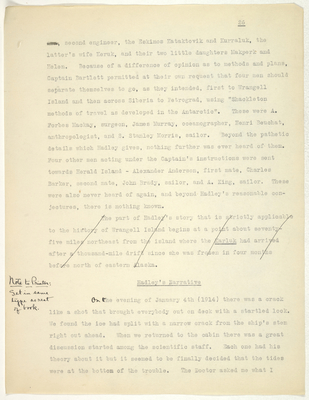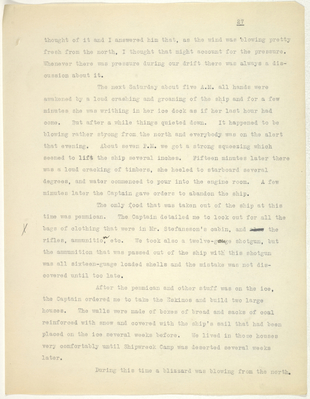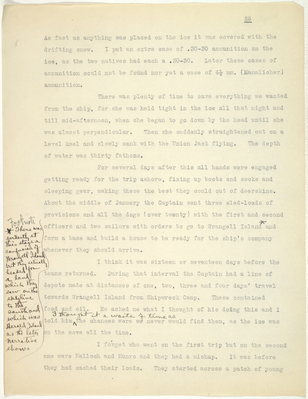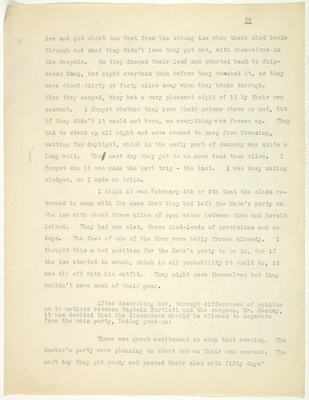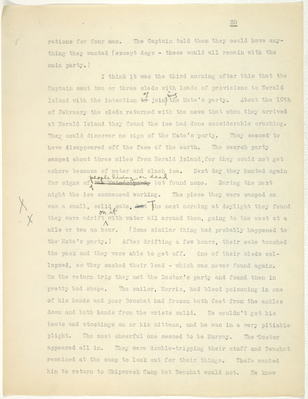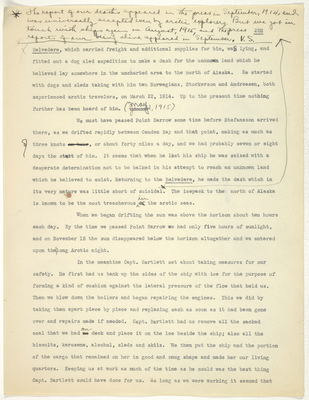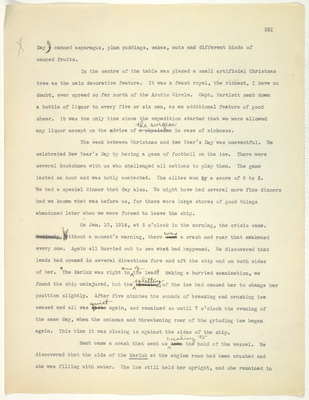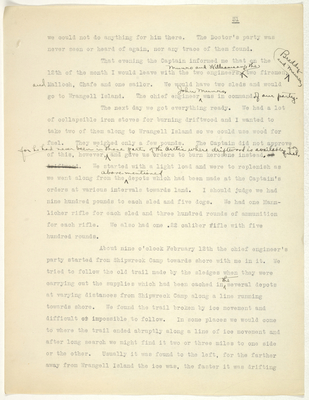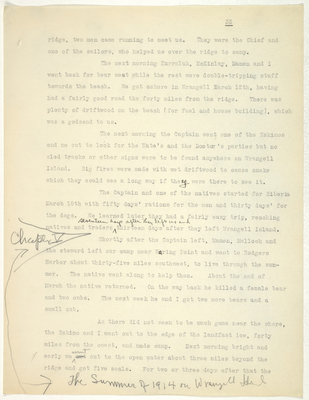Pages That Need Review
stefansson-wrangel-09-26-001
stefansson-wrangel-09-26-001-041
26
[non], second engineer, the Eskimos Kataktovik and Kurraluk, the latter' s wife Keruk, and their two little daughters Makperk and Helen. Because of a difference of opinion as to methods and plans, Captain Bartlett permitted at their own request that four men should separate themselves to go, as they intended, first to Wrangell Island and then across Siberia to Petrograd, using "Shackleton methods of travel as developed in the Antarctic". These were A. Forbes Mackay, surgeon, James Murray, oceanographer, Henri Beuchat, anthropologist, and S. Stanley Morris, sailor. Beyond the pathetic details which Hadley gives, nothing further was ever heard of them. Four other men acting under the Captain's instructions were sent towards Herald Island - Alexander Anderson, first mate, Charles Barker, second mate, John Brady, sailor, and A. King, sailor. These were also never heard of again, and beyond Hadley's reasonable conjectures, there is nothing known.
The part of Hadley's story that is strictly applicable to the history of Wrangell Island begins at a point about seventyfive miles northeast from the island where the Karluk had arrived after a thousand-mile drift since she was frozen in four months before north of eastern Alaska.
Note to Printer: Set in same type as rest of book.
Hadley's Narrative
On tThe evening of January 4th (1914) there was a crack like a shot the brought everybody out on deck with a startled look. We found the ice had split with a narrow crack from the ship’s stem right out ahead. We we returned to the cabin there was a great discussion started among the scientific staff. Each one had his theory about it but it seemed to be finally decided that the tides were at the bottom of the trouble. The Doctor asked me what I
stefansson-wrangel-09-26-001-042
27
thought of it and I answered him that, as the wind was blowing pretty fresh from the north, I thought that might account for the pressure. Whenever there was pressure during our drift there was always a discussion about it.
The next Saturday about five A.M. all hands were awakened by a loud crashing and groaning of the ship and for a few minutes, she was writhing in her ice dock as if her last hour had come. But after a while things quieted down. It happened to be blowing rather strong from the north and everybody was on the alert that evening. About seven P.M. we got a strong squeezing which seemed to lift the ship several inches. Fifteen minutes later there was a loud cracking of timbers, she heeled to starboard several degrees, and water commenced to pour into the engine room. A few minutes later the Captain gave orders to abandon the ship.
The only food that was taken out of the ship at this time was pemmican. The Captain detailed me to look out for all the bags of clothing that were in Mr. Stefansson's cabin, and aloe the rifles, ammunition, etc. We took also a twelve-gauge shotgun, but the ammunition that was passed out of the ship with this shotgun was all sixteen-guage loaded shells and the mistake was not discovered until too late.
After the pemmican and other stuff was on the ice, the Captain ordered me to take the Eskimos and build two large houses. The walls were made of boxes of bread and sacks of coal reinforced with snow and covered with the ship’s sail that had been placed on the ice several weeks before. We lived in those houses very comfortably until Shipwreck Camp was deserted several weeks later.
During this time a blizzard was blowing from the north.
stefansson-wrangel-09-26-001-043
28
As fast as anything was placed oil the ice it was covered with the drifting snow. I put an extra case of .30-30 ammunition on the ice, as the two natives had each a .30-30. Later these cases of ammunition could not he found nor yet a case of 6 1/2 mm. (Mannlicher) ammunition.
There was plenty of time to save everything we wanted from the ship, for she was held tight in the ice all that night and till mid-afternoon, when she began to go down by the head until she was almost perpendicular. Then she suddenly straightened out on a level keel and slowly sank with the Union Jack flying. The depth of water was thirty fathoms.
For several days after this all hands were engaged getting ready for the trip ashore, fixing up boots and socks and sleeping gear, making these the best they could out of deerskins. About the middle of January the Captain sent three sled-loads of provisions and all the dogs (over twenty) with the first and second officers and two sailors with orders to go to Wrangell Island* and form a base and build a house to be ready for the ship’s company whenever they should arrive.
I think it was sixteen or seventeen days before the teams returned. During that interval the Captain had a line of depots made at distances of one, two, three and four days’ travel towards Wrangell Island from Shipwreck Camp. These contained food and oil. He asked me what I thought of his doing this and I told him I thought it was a waste of time as the chances were we never would find them, as the ice was on the move all the time.
I forget who went on the first trip but on the second one were Malloch and Munro and they had a mishap. It was before they had cached their loads. They started across a patch of young
Footnote *There was evidently at this stage a confusion of Wrangell Island but they actually headed for a land which they saw on the skyline to the south and which was Herald Island as the later narrative shows
stefansson-wrangel-09-26-001-044
29
ice and got about ten feet from the strong ice when their sled broke through and what they didn’t lose they got wet, with themselves in the bargain. So they dumped their load and started back to Shipwreck Camp, but night overtook them before they reached it, as they were about thirty or forty miles away when they broke through. When they camped, they had a very pleasant night of it by their own account. I forget whether they lost their primus stove or not, but if they didn't it would not burn, as everything was frozen up. They had to stand up all night and move around to keep from freezing, waiting for daylight, which in the early part of January was quite a long wait. The next day they got to us more dead than alive. I forget who it was made the next trip - the last. I was busy making sledges, so I made no trips.
I think it was February 4th or 5th that the sleds returned to camp with the news that they had left the Mate's party on the ice with about three miles of open water between them and Herald Island. They had one sled, three sled-loads of provisions and no dogs. The feet of one of the four were badly frozen already. I thought this a bad position for the Mate's party to be in, for if the ice started to crush, which in all probability it would do, it was all off with his outfit. They might save themselves but they wouldn't save much of their gear.
After describing how, through differences of opinion as to methods between Captain Bartlett and the surgeon. Dr. Mackay, it was decided that the dissenters should be allowed to separate from the main party, Hadley goes on:
There was great excitement in camp that evening. The Doctor's party were planning to start out on their own account. The next day they got ready and packed their sled with fifty days'
stefansson-wrangel-09-26-001-045
30
rations for four men. The Captain told them they could have anything they wanted (except dogs - these would all remain with the main party.)
I think it was the third morning after this that the Captain sent two or three sleds with loads of provisions to Herald Island with the intention to of joining the Mate’s party. About the 10th of February the sleds returned with the news that when they arrived at Herald Island they found the ice had done considerable crushing. They could discover no sign of the Mate’s party. They seemed to have disappeared off the face of the earth. The search party camped about three miles from Herald Island, for they could not get ashore because of water and slush ice. Next day they hunted again for signs of people living or deadthe Mate's party but found none. During the next night the ice commenced working. The piece they were camped on X was a small, solid cake, but Tthe next morning at daylight they found X they were adrift on it with water all around them, going to the west at a mile or two an hour. (Some similar thing had probably happened to the Mate’s party.) After drifting a few hours, their cake touched the pack and they were able to get off. One of their sleds collapsed, so they cached their load - which was never found again. On the return trip they met the Doctor’s party and found them in pretty bad shape. The sailor, Morris, had blood poisoning in one of his hands and poor Beuchat had frozen both feet from the ankles down and both hands from the wrists solid. He couldn’t get his boots and stockings on or his mittens, and he was in a very pitiable plight. The most cheerful one seemed to be Murray. The Doctor appeared all in. They were double-tripping their stuff and Beuchat remained at the camp to look out for their things. Chafe wanted him to return to Shipwreck Camp but Beuchat would not. He knew
stefansson-wrangel-09-26-001-035
The report of our deaths appeared in the press in September, 1914, and was universally accepted even by arctic explorers. But we got in touch with ships again in August, 1915, and the press reports of our being alive appeared in September, U. S.
Belvedere, which carried freight and additional supplies for him, was lying, and fitted out a dog sled expedition to make a dash for the unknown land which he believed lay somewhere in the uncharted area to the north of Alaska. He started with dogs and sleds taking with him two Norwegians, Storkerson and Andreasen, both experienced arctic travelers, on March 22, 1914. Up to the present time nothing further has been heard of him. (June May, 1915)
We must have passed Point Barrow some time before Stefansson arrived there, as we drifted rapidly between Camden Bay and that point, making as much as three knots an hour, or about forty miles a day, and we had probably seven or eight days the statt of him. It seems that when he lost his ship he was seized with a desperate determination not to be balked in his attempt to reach an unknown land which he believed to exist. Returning to the Belvedere, he made the dash which in its very nature was little short of suicidal. The icepack to the north of Alaska is known to be the most treacherous of in the arctic seas.
When we began drifting the sun was above the horizon about ten hours each day. By the time we passed Point Barrow we had only five hours of sunlight, and on November 15 the sun disappeared below the horizon altogether and we entered upon the|long Arctic night.
In the meantime Capt. Bartlett set about taking measures for our safety. He first had us bank up the sides of the ship with ice for the purpose of forming a kind of cushion against the lateral pressure of the floe that held us. Then we blew down the boilers and began repairing the engines. This we did by taking them apart piece by piece and replacing each as soon as it had been gone over and repairs made if needed. Capt. Bartlett had us remove all the sacked coal that we had no on deck and place it on the ice beside the ship; also all the biscuits, kerosene, alcohol, sleds and skiis. We then put the ship and the portion of the cargo that remained on her in good and snug shape and made her our living quarters. Keeping us at work as much of the time as he could was the best thing Capt. Bartlett could have done for us. As long as we were working it seemed that
stefansson-wrangel-09-26-001-037
into them. All about the ship were ringlike depressions in the snow worn by the dogs lying there and melted by the warmth of their bodies. Each dog had his own nest. If one attempted to intrude upon the rights of another bickerings were sure to follow; but this did not occur often, as these husky animal , though shrewd and cunning generally play fair toward each other. They are kind and friendly to their masters and faithful in their devotion to men.
The men spent most of their time aboard ship. There was about two hours' work a day for each, and the remainder of the time was spent in sleeping, reading, playing cards, chess and checkers, and listening to music furnished by a from our phongraph Victrola. We had an abundance of fine records that were an ever-living source of pleasure. We were well supplied with good reading matter, in thw linw" gf books and magazines. The forethought of Dr. Stefansson in supplying us with the means of entertainment was one of the wisest precautions he could have taken.
The Karlulc was supplied with the best of provisions to last her three years. We also had large quantities of foods in more condensed form for use on the trail. While on the ship no restrictions were put upon the amount of food allowed to each man; everything was furnished in plenty. We procured fresh water from an old ice floe of ice, that is ice that was several years old. The effect of the sun upon ocean the ice is gradually to draw the salt from it.
We had been drifting so long without any unusual incident that our ship became a veritable home to us. We had comfort and plenty on board, and in a measure forgot the our helplessness. of our situation. Capt. Bartlett, perhaps was the only person who- thoroughly realized and appreciated the dangers ahead of us, but he went about his work calmly preparing against disaster to the ship.
Day succeeded day in the same monotonous way, until one night in the early part of December we were suddenly aroused by a strong reminder of what was in store for us. About 9 o'clock ion the evening in question, as we were sitting in the cabin entertaining ourselves with music, reading and games, we were startled
stefansson-wrangel-09-26-001-039
25I
Day) canned asparagus, plum puddings, cakes, nuts and different kinds of canned fruits.
In the centre of the table was placed a small artificial Christmas tree as the main decorative feature. It was a feast royal, the richest, I have no doubt, ever spread so far north of the Arctic Circle. Capt. Bartlett sent down a bottle of liquor to every five or six men, as an additional feature of good cheer. It was the only time since the expedition started that we were allowed any liquor except on the advice of a physician the surgeon in case of sickness.
The week between Christmas and New Year's Day was uneventful. We celebrated New Year's Day by having a game of football on the ice. There were several Scotchmen with us who challenged all nations to play them. The game lasted an hour and was hotly contested. The allies won a score of 8 to 3. We had a special dinner that day also. We might have had several more fine dinners had we known what was before us, for there were large stores of good things abandoned later when we were forced to leave the ship.
On Jan. 10, 1914, at 5 o'clock in the morning, the crisis came. Suddenly Without a moment's warning, there came was a crash and roar that awakened every one. Again all hurried out to see what had happened. We discovered that leads had opened in several directions fore and aft the ship and on both sides of her. The Karluk was right in one of leads. Making a hurried examination, we found the ship uninjured, but the breaking splitting of the ice had caused her to change her position slightly. After five minutes the sounds of breaking and crushing ice ceased and all was quite quietagain, and remained so until 7 o’clock the evening of the same day, when the ominous and threatening roar of the grinding ice began again. This time it was closing in against the sides of the ship.
Next came a crash that sent us into rushing to the hold of the vessel. We discovered that the side of the Karluk at the engine room had been crushed and she was filling with water. The ice still held her upright, and she remained in
stefansson-wrangel-09-26-001-046
31
we could not do anything for him there. The Doctor's party was never seen or heard of again, nor any trace of them found.
That evening the Captain informed me that on the 12th of the month I would leave with the two engineer, Munro and Williamson, the two firemen, Buddy and Maurer, and Malloch, Chafe and one sailor. We would have two sleds and would go to Wrangell Island. The chief engineer John Munro, was in command of our party.
The next day we got everything ready. We had a lot of collapsible iron stoves for burning driftwood and I wanted to take two of them along to Wrangell Island so we could use wood for fuel. They weighed only a few pounds. The Captain did not approve of this, however, for he had never been in these parts of the Arctic where driftwood is available for fuel, and gave us orders to burn heroine instead. of driftwood. We started with a light load and were to replenish as we went along from the above mentioned depots which had been made at the Captain's orders at various intervals towards land. I should judge we had nine hundred pounds to each sled and five dogs. We had one Mannlieher rifle for each sled and three hundred rounds of ammunition for each rifle. We also had one .22 caliber fifle with five hundred rounds.
About nine o'clock February 12th the chief engineer's party started from Shipwreck Camp towards shore with me in it. We tried to follow the old trail made by the sledges when they were carrying out the supplies which had been cached in the several depots at varying distances, from Shipwreck Camp along a line running towards shore. We found the trail broken by ice movement and difficult or impossible to follow. In some places we would come to where the trail ended abruptly along a line of ice movement and after long search we might find it two or three miles to one side or the other. Usually it was found to the left, for the farther away from Wrangell Island the ice was, the faster it was drifting
stefansson-wrangel-09-26-001-050
35
ridge, two men came running to meet us. They were the Chief and one of the sailors, who helped us over the ridge to camp.
The next morning Kurraluk, McKinlay, Mamen and I went hack for bear meat while the rest were double-tripping stuff towards the heach. We got ashore in Wrangell March 12th, having had a fairly good road the forty miles from the ridge. There was plenty of driftwood on the heach (for fuel and house building), which was a godsend to us.
The next morning the Captain sent one of the Eskimos and me out to look for the Mate’s and the Doctor’s parties hut no sled tracks or other signs were to he found anywhere on Wrangell Island. Big fires were made with wet drift-wood to cause smoke which they could see a long way if therey were there to see it.
The Captain and one of the natives started for Siberia March 18th with fifty days’ rations for the men and thirty- days’ for the dogs. We learned later, they had a fairly easy trip, reaching natives and traders seventeen days after they left us and thirteen days after they left Wrangell Island.
Shortly after the Captain left, Mamen, Malloch and the steward left our camp near Waring Point and went to Rodgers Harbor about thirty-five miles southwest, to live through the summer. The native went along to help them. About the end of March the native returned. On the way back he killed a female hear and two cubs. The next week he and I got two more hears and a small cub.
As there did not seem to he much g:ame near the shore, the Eskimo and I went out to the edge of the landfast ice, fortymiles from the coast, and made camp. Next morning bright and early we wnt went out to the open water about three miles beyond the ridge and got five seals. For two or three days after that the
The Summer of 1914 on Wrangell Island
